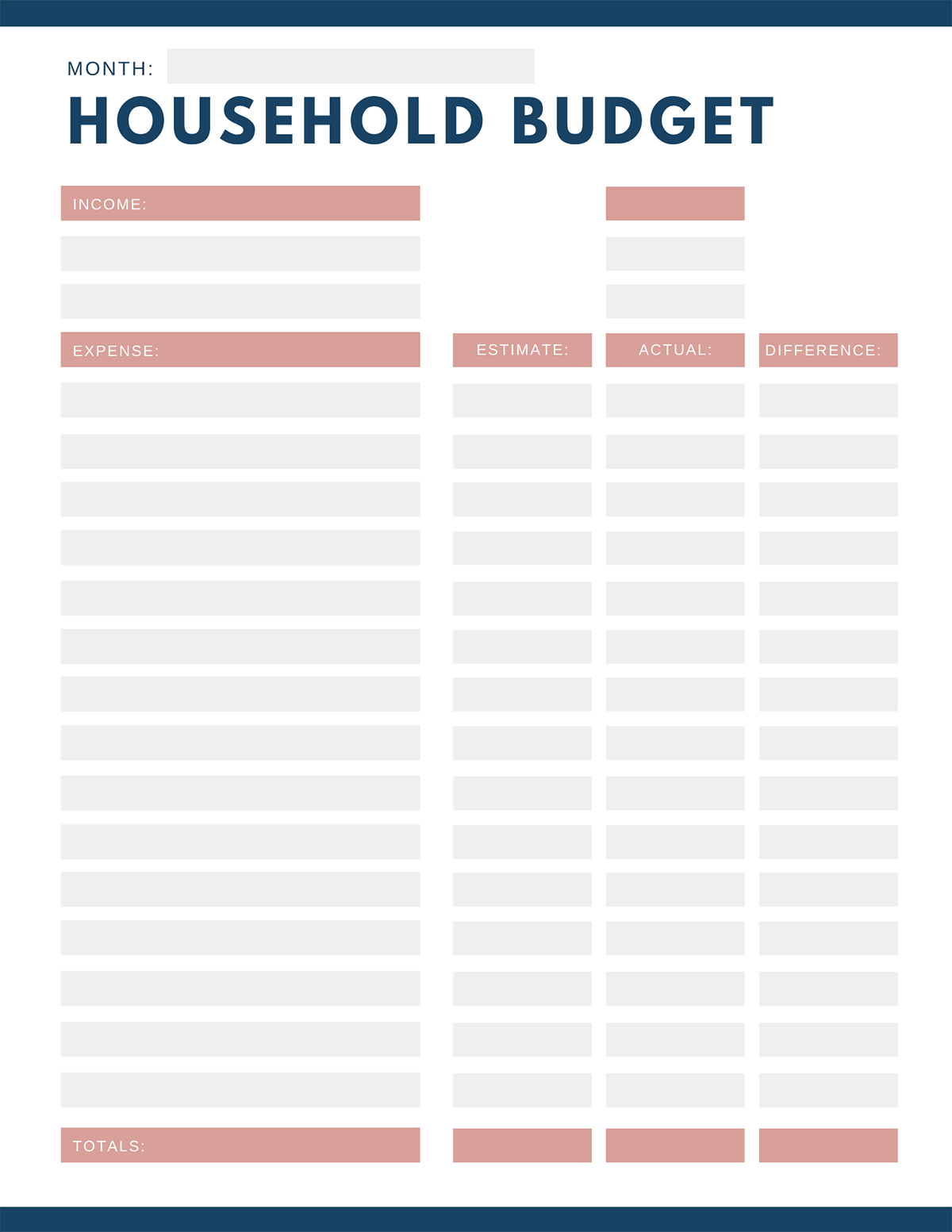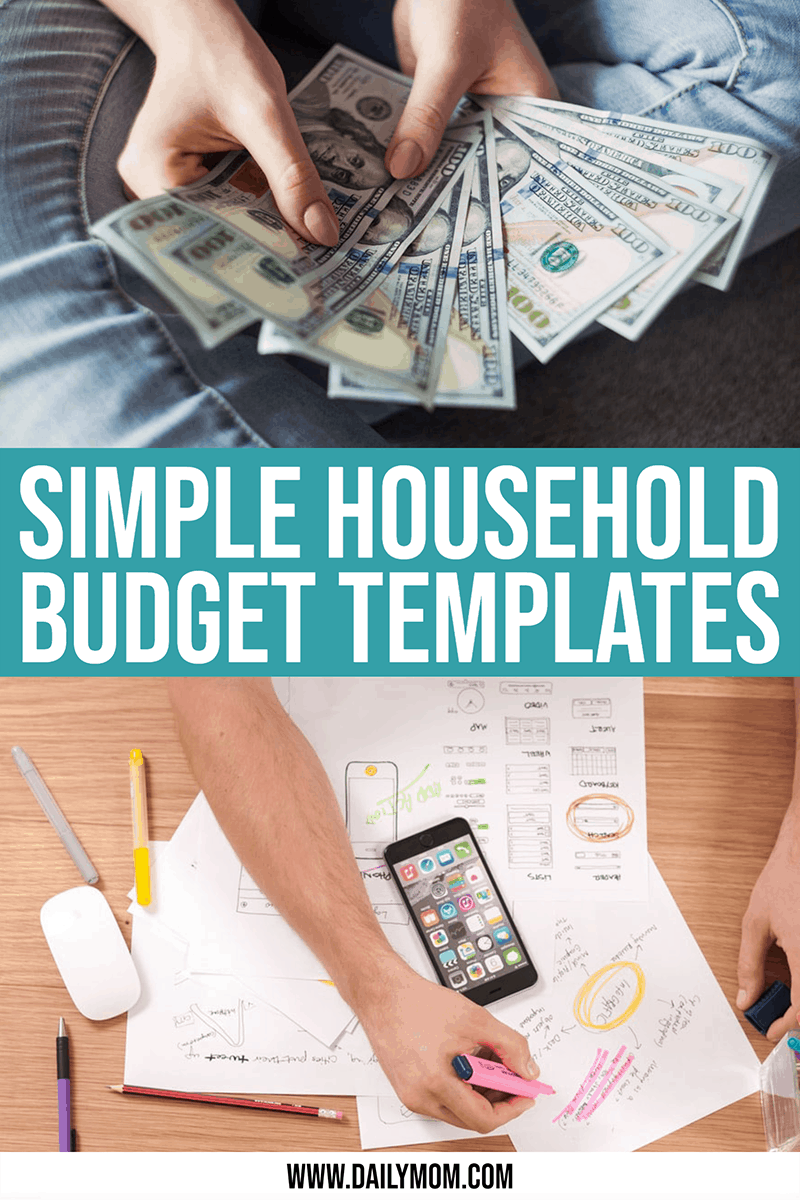A “financially fit” family uses a household budget template to track their expenses and income. Why? Well, to start, it’s an easy way to make it a topic of conversation and stay financially healthy. Finance is one of the top topics that people don’t like talking about. In fact, many even many couples don’t discuss finances with each other. Most want to avoid tension and arguments, and one way that occurs it to talk about money. This is why it’s no surprise finances is commonly cited as the primary reasons couples divorce. But it doesn’t have to be.
Once finances are made part of regular discussion in a partnership, it’s actually pretty easy to talk about and manage. Discussing the current financial situation, sharing financial goals, and creating good habits is a good idea for anyone, especially a family. And one of the easiest ways to make a change for financial health is by following a household budget template. Regardless of how much money someone makes, or currently has in the bank, a budget is a key tool for reaching any financial goals. Below is exactly how to create and stick to a budget, including a Household Budget Template to help get started.
Read More: Budget Basics for Busy Moms
What is a household budget?
A family or household budget is really just a plan of how income is going to be spent or distributed over a certain period of time, typically monthly. Some may think a budget is restricting and doesn’t allow spending but that’s far from the truth. In fact, a budget allows for spending the way that someone may need to, and want to! Budgeting is actually rewarding!
Since budgeting is really just a spending plan, it ensures enough money will be allocated to cover monthly needs like utilities and bills, and gives visibility to how much extra money is available for spending, paying off debt, or saving! And speaking of saving, 31% of people have only $500 or less in savings, and an unbelievable 19% of people have ZERO. Whoa, scary.
Most people may say, “Hey, I want that jacket and those shoes, but not sure if I have the money to do so. I feel as if I’ve been spending a lot this month, so I guess I’ll pass.” But with a budget, it’s easy to take a look and say, “Awesome, I have enough for the jacket, and since I haven’t spent all of our entertainment budget this month, I’d rather use that money to pay for the shoes.” A budget is all about giving visibility to what you have and what you’ve spent.
Read More: 10 Ways to Budget Before Baby
How to Create and Use A Household Budget Template
Attempting to save money, pay off debt, or just more efficiently spend money can only best be done by keeping a budget. However, only about ⅓ or 32% of households actually use one. What one may not know is that creating one doesn’t have to be complicated. Sure, it’ll take a little time, but just as time is made in a schedule for self-care, financial care is just as important and can be booked in a schedule each month just the same.
- Get on the same page. A couple and family need to be on the same page. If a spouse decides he or she doesn’t agree with the plan of following a budget, it won’t work. If older children are involved, they too need to be on the same page and understand what the parents are trying to accomplish. A family meeting is a great way to start the conversation and make sure all voices are heard. If a spouse or family isn’t on the same page, sitting down with them to discuss their worries and concerns is the best way to change their mind.
- Make a goal. Once everyone is on the same page, a goal needs to be created. Maybe it’s paying off all the household debt – which is a big part of having amazing finances. Or maybe it’s saving for a child’s college, a coveted vacation or cruise in the Caribbean, or a new car (or new to you, because let’s face it – new cars aren’t the best financially compared to slightly used cars). Whatever the goal, everyone needs to agree and work towards the same goal.
- Gather all the household financial information. This is undoubtedly the biggest part of the entire process. But it’s also the most crucial. All income, bills, and monthly expenses need to be listed. Income is money received (after taxes). Bills are money owed for stuff or services – like electric, phone service, car payment, Netflix, student loan, childcare, credit card payment, etc. And monthly expenses are monies expected to be used monthly and usually fluctuates depending on how one spends or saves. These are items like groceries, entertainment, gasoline, etc.
One of the best ways to find this information and not miss anything is to look at your bank statements. This may take a while, but all this information is key to creating a good budget. - Organize your first budget. This is where every single income and expense is listed and calculated.
Below is a simple printable to help create a household budget template. Using this template will help kick off any household budget quickly and keep it organized. However, also using an app like EveryDollar will also help keep your budget organized and you’ll always have it on the go. Once initially done, the list just requires a little upkeep each month (adding/deleting any new or old income or expenses).
Read More: 10 Backyard Water Activities on a Budget
How to Keep It Up
Maintaining a budget is pretty simple. Most income and bills will rollover from the previous month (unless there’s been a change in income or a bill has been paid off). Before the beginning of each month, a couple or family should sit together and discuss any new or potentially unexpected expenses (field trip money, car repair, etc.) to add to the budget. Then it’s ready to go. Every time money is spent, the budget needs to be updated so that one knows how much is left to spend.
And the same goes for income. Creating new or larger income will help reach a financial goal faster. Maybe next month some money can be made by selling off a piece of unused furniture. The money made from that sale can be used as “income” and should be budgeted just the same.
It takes about 2-3 months to really get into the groove of the household budget template and keeping it up with income and expenses, but once a family is regularly sticking to it, goals can be reached and the motivation increases.
To keep the motivation going, print out the goal and post it up so everyone can see it each day. This not only makes the goal real but keeps one’s mind on it all the time. Another great idea is to fill in a portion of the goal as it’s paid off so the family can see how much progress has been made and how much is left.
Once started, keeping one’s budget should be very simple. Just like walking the dog, watering the plant, and paying monthly bills, working through the budget should become a regular task, and a part of a family’s routine.

A household budget shouldn’t be scary. In fact, when a family starts to see the benefits (saving up for that trip to Disney World!) everyone should be motivated to keep working at it and get excited! Sure, it’s just a little awkward to discuss at first and takes a little work pulling it together, but once a family is into the groove with a budget, and actively managing it, goals will be reached, and benefits will be reaped.
WANT TO READ MORE?
Ready to take the next step? Check out Flexible Family Budget – Adjusting Spending Habits As Your Children Grow.
💖 NEWSLETTER: DAILY READS IN YOUR INBOX 💖
Sign up to receive our picks for the best things to do, see and buy so you can relax and focus on more important tasks! Let us help you be the best version of yourself you can be!
GET MORE FROM DAILY MOM, PARENTS PORTAL
Newsletter: Daily Mom delivered to you
Facebook: @DailyMomOfficial
Instagram: @DailyMomOfficial | @DailyMomTravel | @BestProductsClub
YouTube: @DailyMomVideos
Pinterest: @DailyMomOfficial
📌 LOVE IT? PIN IT!📌










































